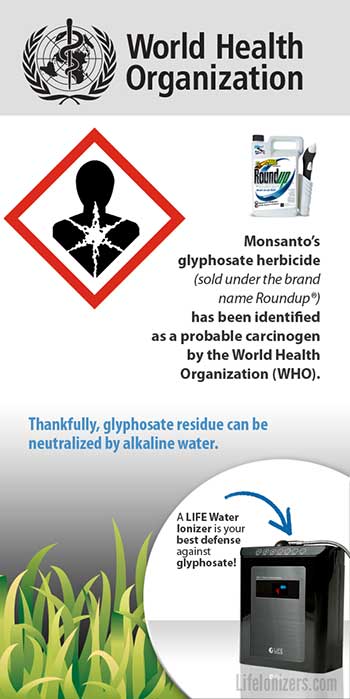Health Threat of Glyphosate Understated by EPA by Life Water Ionizers
Monsanto’s glyphosate herbicide (sold under the brand name Roundup) has been identified as a probable carcinogen by the World Health Organization (WHO).

Despite a vicious backlash by Monsanto, the WHO believes firmly enough in their findings to stand their ground. So is glyphosate in your water? Probably. Glyphosate is the most widely used herbicide on the market today. You should definitely be concerned if you live in an area with lots of agriculture, such as farming. The EPA limits the amount of glyphosate allowed in water supplies, but it does not take into account other ways that you can be exposed to glyphosate. And you don’t have to live near a farm to be at risk!
How the EPA Regulates Glyphosate in Water
The EPA sets a Maximum Containment Level (MCL) for glyphosate in drinking water of 700 parts per billion, which the EPA believes is safe. However, most of the testing of glyphosate in the US is done on the chemical in isolation. In the real world, glyphosate is combined with other chemicals, such as surfactants and adjuvants. These additional chemicals make it a more effective herbicide – but may also make it more toxic to humans and animals.
The testing relied on by the WHO to determine that glyphosate is a probable carcinogen was different. Much of the research relied on by the WHO looked at the effects of glyphosate combined with the other chemicals it is commonly used within real-world herbicide formulations. The research that the WHO used was a lot more comprehensive than the research that the EPA used. That’s why the WHO found reasons to be concerned about the effects of glyphosate and the EPA didn’t.
The other way you are exposed to glyphosate that the EPA isn’t telling you about
Tap water isn’t the only way that you are exposed to glyphosate. Your produce is most likely covered in it. Glyphosate is the most commonly applied herbicide used in agriculture today. Its use has skyrocketed since the introduction of “Roundup Ready” GMO foods. In fact, it’s likely that you are exposed to more glyphosate by your produce then you are by your drinking water! Thankfully, glyphosate residue can be neutralized by alkaline water.
A Life Water Ionizer is your best defense against glyphosate
Filtration: Glyphosate can be effectively filtered out of water by granular activated carbon (GAC) filters, and all Life water ionizers come with two internal filters that have GAC filter media. But that’s not all a Life Ionizer will do to protect you from glyphosate. Every Life Ionizer comes with a free custom-configured prefilter system that targets the toxins found in your local water supply. Life Ionizers finds out what toxins are in your water by an analysis of your local water utility’s annual water quality report to the EPA. That report lists all of the toxins found in your water over the course of a year. If you have high levels of glyphosate or any other toxins, Life Ionizer will configure your water ionizer’s filtration system to address them.
Glyphosate neutralization: Another way you can use a Life Ionizer to protect you from glyphosate is to soak your produce in high pH alkaline water. Acidic herbicides like glyphosate are neutralized and broken down by alkaline water, and the higher the pH of the water you use, the better. The top-of-the-line Life M-13 can generate alkaline water with a pH of 12, depending on the quality of your source water. Life water ionizers are the most powerful ionizers on the market, so no matter which model you choose, you will be able to get the powerful, high pH water you need to detoxify your produce of glyphosate and other acidic chemical residues.